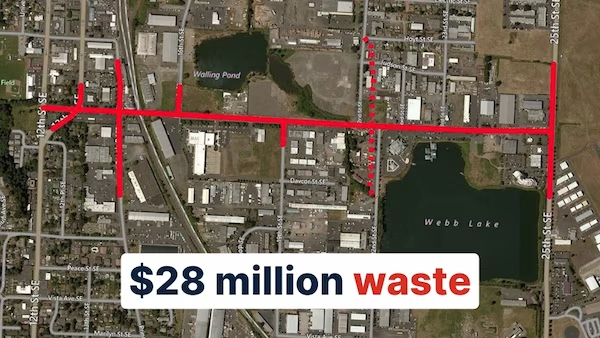Editor's Note: The challenges our cities face are growing, but so is the strength of this movement. Every story we share, every idea we spread, and every tool we build exists because people like you are committed to showing up. Your membership isn’t passive—it’s the momentum that makes change possible.
At the September meeting of the Northwest Louisiana Council of Governments (NLCOG), something unusual happened: nothing.
After more than a decade of monthly meetings, staff announced that future sessions on the I-49 Inner City Connector were canceled because there were “no actionable events” left to discuss. That dry bureaucratic phrasing might seem unremarkable, but in Shreveport, it landed with a thud. For the residents of Allendale — a neighborhood that has lived under the threat of demolition for years — it felt like the highway project that haunted them might finally be dead.
But is it really dead?
Highway projects have a way of lurching back to life, often after years or even decades of dormancy. They never seem to die outright. Instead, they hang around as “zombie projects,” sustained by federal funding formulas, political inertia, and the persistence of local elites who see their fortunes tied to concrete poured through someone else’s neighborhood.
Allendale Strong, the grassroots group that fought this project from the beginning, has good reason to celebrate. Yet the deeper truth is that the neighborhood cannot fully heal — and cannot attract the investment and confidence it deserves — until the project is not just paused but permanently abandoned.
A Neighborhood That Keeps Coming Back
To understand what’s at stake for Allendale, you have to look back.
Earlier this month, the Shreveport Times published a centennial history of the neighborhood, marking 100 years since the 1925 fire that destroyed nearly 200 homes and left 1,000 people homeless. Fifteen years later, a tornado swept through, damaging houses and scattering families. Each time, the community rebuilt. By the 1950s, Allendale was thriving again — diverse, safe, and affordable. As longtime resident Rosie Chaffold later recalled, “everyone worked, everyone cared for their property, all children were in school.”
Then came the highways.
In 1959, Interstate 20 cut directly through Allendale. It displaced 5,000 people, leveled schools and businesses, and destroyed what was once known as Shreveport’s Black Wall Street. By 1970, the neighborhood had lost more than half its population. What natural disasters had failed to do, federal infrastructure accomplished. The decline that followed was not inevitable — it was policy-driven.
When I first visited Allendale years ago, I expected to find little more than abandonment and decay. And yes, the signs of poverty were visible. But what struck me — and what I wrote about in an entire chapter on the I-49 project in "Confessions of a Recovering Engineer" — was the stubborn resilience I encountered. Freshly cut lawns and tended flowerbeds. Signs in windows declaring love for the neighborhood. Neighbors waving to a sweaty outsider carrying his luggage. And most of all, Ms. Rosie’s garden, a simple act of beauty and defiance that testified to a deeper truth: this place still mattered.
Today, Allendale’s population is fewer than 4,000. But it is not a place without hope. Community Renewal, the Fuller Center for Housing, and countless residents have planted gardens, restored homes, and rebuilt civic life. Allendale Strong emerged from this work, determined to resist a repeat of the destruction that Interstate 20 unleashed.
The Cost of a Zombie Project
Even the threat of I-49 has harmed Allendale.
For more than a decade, the neighborhood has lived under the shadow of a potential bulldozer. Property values stagnated. Investments that should have gone into housing, businesses, and civic improvements never materialized. Who wants to buy or build in a place that might be condemned? Hanging the possibility of demolition over a community is itself a slow form of demolition.
This is the cruelest feature of zombie projects: They do damage even when they never get built.
And they rarely stay buried, because our federal system is designed to keep them alive. The Highway Trust Fund — once sustained by gas taxes, now insolvent and perpetually bailed out with general revenues — is used to funnel money into large, capital-intensive projects. Federal and state formulas reward size and cost, not effectiveness or local benefit. That’s why a billion-dollar megaproject like I-49 is easier to fund than a million dollars of crosswalks, sidewalks, and street repairs — even though the latter would do far more good.
The persistence of I-49 was never about solving Shreveport’s transportation problems. It was about feeding the machine.
And that machine has shaped our entire national approach to economic development. Instead of nurturing entrepreneurs, strengthening neighborhoods, and investing in the small, local steps that build community wealth and capacity, we’ve chosen to measure progress in cubic yards of concrete. Federal spending on highways has become the default strategy for growth, even as it hollows out the very places it was supposed to serve.
If Allendale is to truly recover, the project can’t just be tabled. It must be ended, decisively and permanently. And if America is to recover, we need to do the same: Stop propping up zombie highways with federal subsidies, and pivot our investments toward local, bottom-up strategies that actually make our neighborhoods stronger.



.webp)

